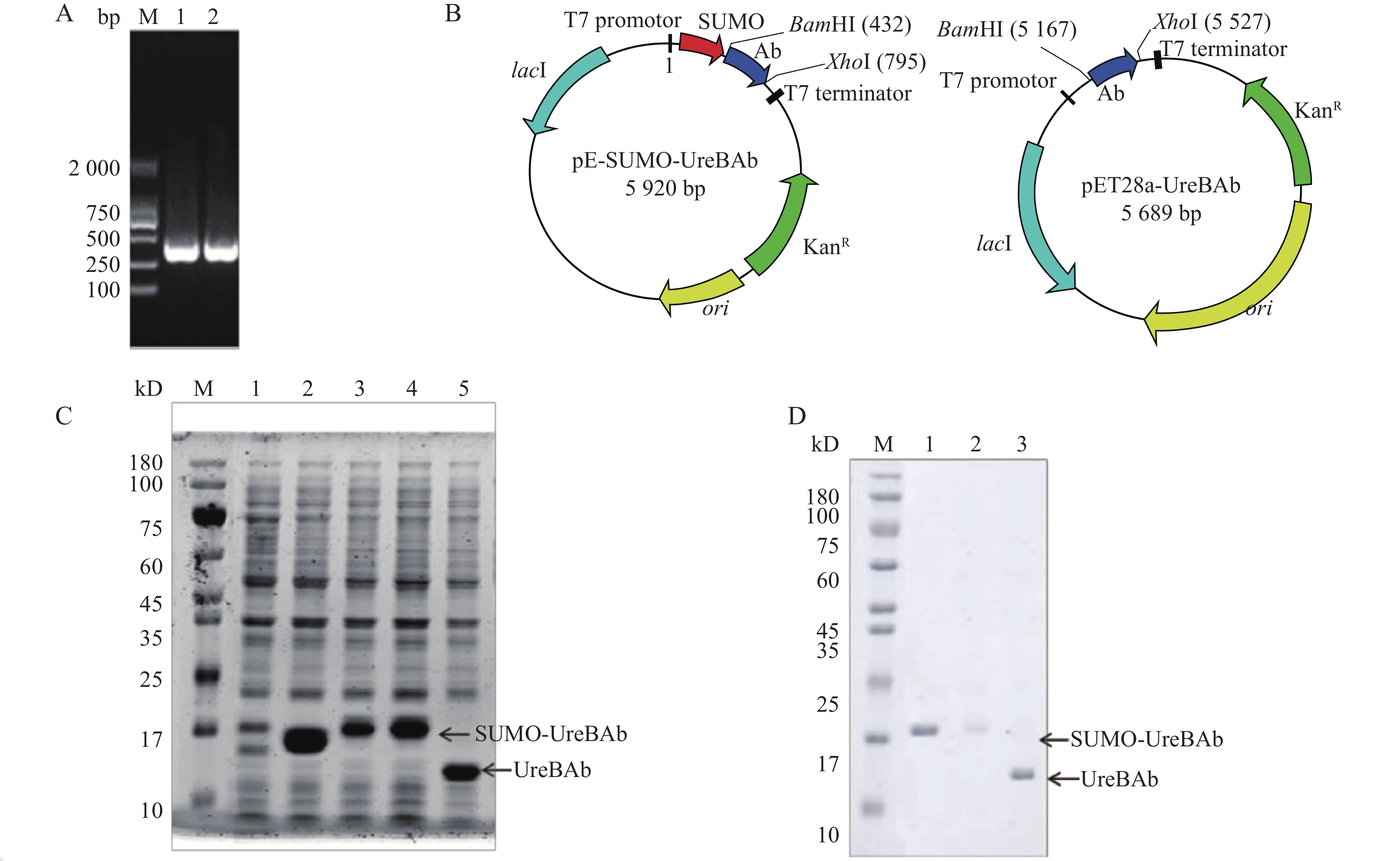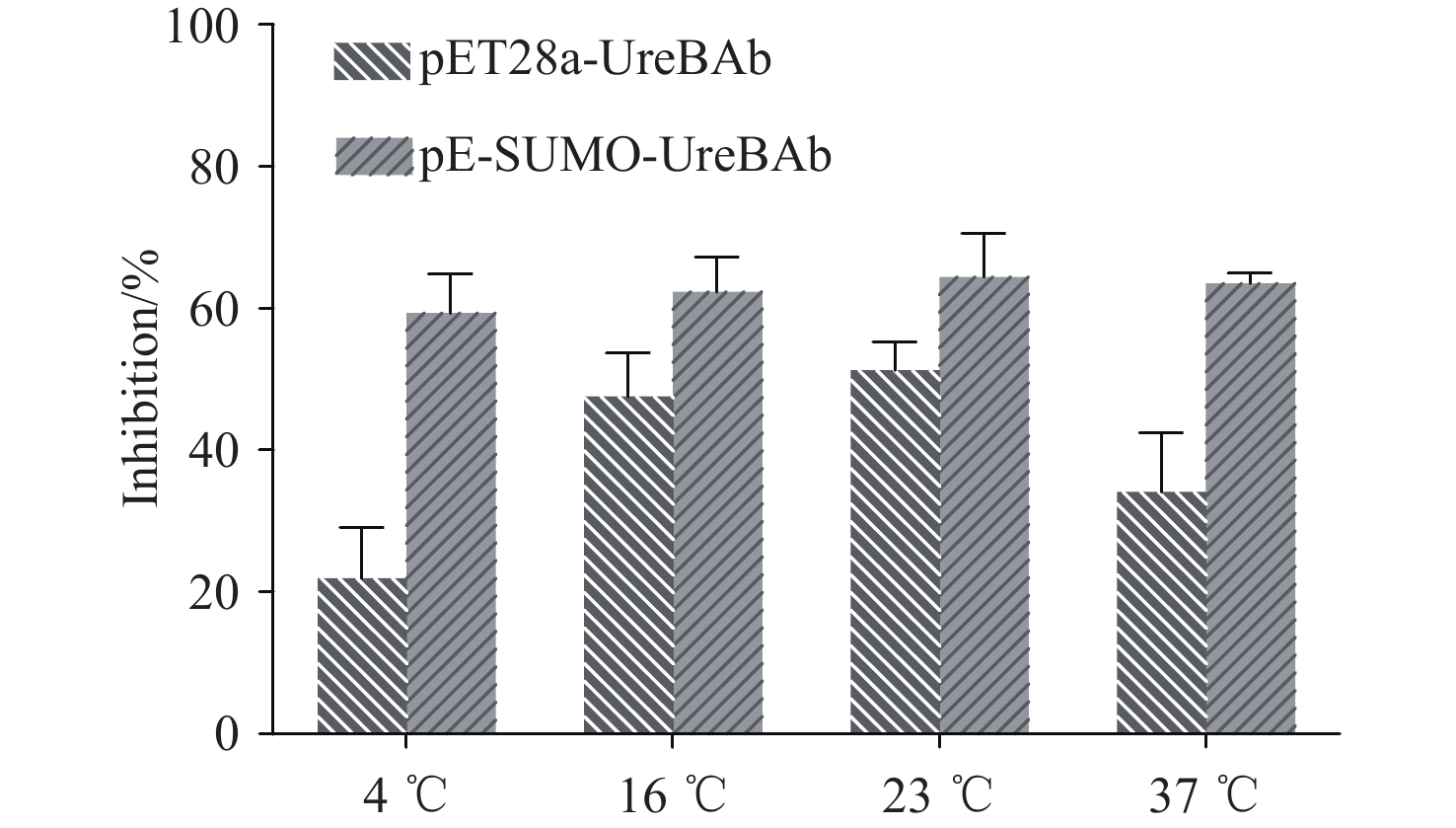Genetic engineering and molecular modification of recombinant fully humanized single-domain antibody against Helicobacter pylori UreB
-
摘要:
为了构建针对幽门螺杆菌(Helicobacter pylori,Hp)脲酶的单域抗体的基因工程表达系统。首先利用Pymol、I-TASSER和ClussPro2等AI辅助工具分析比较了不同抗体与Hp脲酶亚单位B(UreB)之间的分子间作用力,确定了VL全人源化单域抗体UreBAb作为重点研究对象。根据大肠埃希菌密码子偏好性优化了UreBAb基因序列,并将其分别插入pET28a、pE-SUMO等表达载体,转化大肠埃希菌Rosetta(DE3)获得了重组表达菌株,通过IPTG诱导制备重组抗体蛋白,并利用提取的Hp脲酶作为抗原,分析验证了重组表达抗体的活性。SDS-PAGE检测结果显示UreBAb和SUMO-UreBAb均获得了正确的表达,纯化后的蛋白产率分别为0.34和0.41 mg/mL。单向免疫扩散实验结果证实这两种重组表达抗体均与Hp UreB抗原具有良好的亲和力,对脲酶的抑制率分别为51.27%和74.07%。进而,结合AlphaFold2、cluspro2、mCSM-AB、OSPREY和FoldX等人工智能工具,评估分析了影响抗原-抗体复合物稳定性的关键位点及其突变策略,随后进一步构建了9个UreBAb进化突变体表达菌株,活性分析结果显示,这些突变体与抗原的结合活性均得到了提高,其中以I107W突变体的活性提升最为显著,相较于野生型UreBAb,提高了24.95%。本研究为Hp全人源化单域抗体的开发奠定了良好的基础。
Abstract:To construct a recombinant expression system for a single-domain antibody targeting the urease of Helicobacter pylori (Hp), this study employed several strategies. First, using artificial intelligence (AI) auxiliary tools such as Pymol, I-TASSER, and ClussPro2, the molecular interactions between different antibodies and Hp urease subunit B (UreB) were analyzed. The fully humanized single-domain antibody UreBAb was identified as the primary research target. Next, the UreBAb gene sequence was optimized based on Escherichia coli codon preferences, and was inserted into expression vectors such as pET28a and pE-SUMO. The resulting recombinant expression strains were obtained by transforming Escherichia coli Rosetta(DE3). Recombinant antibody proteins were prepared through IPTG induction, and its activity was detected using extracted Hp urease as the antigen. SDS-PAGE analysis confirmed the correct expression of both UreBAb and SUMO-UreBAb, with protein yields of 0.34 mg/mL and 0.41 mg/mL, respectively. Unidirectional immunodiffusion experiments further confirmed that both recombinant antibodies exhibited strong affinity for Hp UreB antigen, with inhibition rates of 51.27% and 74.07%, respectively. Additionally, leveraging artificial intelligence tools such as AlphaFold2, cluspro2, mCSM-AB, OSPREY, and FoldX, the study evaluated and analyzed key binding sites and mutational strategies affecting the stability of the antigen-antibody complex. Subsequently, nine UreBAb evolution mutants were constructed, and their binding activities with the antigen were enhanced. Among these, the I107W mutant showed the most significant improvement, achieving a 24.95% increase compared to the wild-type UreBAb. This research lays a solid foundation for the development of fully humanized single-domain antibodies against Hp.
-
-
Figure 2. Agarose gel electrophoresis analysis of recombinant expression plasmid of UreBAb
A: PCR verification of the transformant(M: DNA 2000bp marker; 1: pE-SUMO-UreBAb; 2:pET28a-UreBAb); B: Schematic diagram of plasmid pE-SUMO-UreBAb and pET28a-UreBAb; C: Total protein of recomninant E. coli carrying pE-SUMO-UreBAb and pET28a-UreBAb (20 ℃, 15 h)(M: Protein Marker; 1: pET28a; 2: pE-SUMO; 3-4: Different concentrations of pE-SUMO-UreBAb; 5: pET28a-UreBAb); D: Purified SUMO-UreBAb and UreBAb(M: Protein Marker; 1-2: Purification of SUMO-UreBAb at different concentrations; 3: Purified UreBAb)
Figure 3. Affinity and activity analysis of recombinant SUMO-UreBAb and UreBAb with urease($\bar{x}\pm s $,n=3)
A: Affinity of recombinant SUMO-UreBAb with urease(1: PBS; 2-3: SUMO-UreBAb); B: Affinity of r UreBAb with urease(1: PBS; 2: UreBAb); C: Analysis of the effect of recombinant SUMO-UreBAb and UreBAb on urease activity
Figure 7. Recombinant expression and activity analysis of mutated UreBAbs ($\bar{x}\pm s $,n=3)
A: SDS-PAGE analysis of recombinant wild-type UreBAb and 9 mutant UreBAbs (M: Protein Marker; 1:Blank Control;2-3:WT; 4: K43M; 5: K43L; 6: E82W; 7: I107P; 8: R109P; 9: R109N; 10: K43T; 11: I107W; 12: I107F); B: Antigen (urease) inhibition rate of UreBAb and 9 mutants at 37 °C *P<0.05, **P<0.01, ***P<0.001 vs UreBAb
Table 1 Primers used in plasmids construction
Primer Primer sequence(5′→3′) Purpose pET28a-UreBAb-F CGCGGATCCACCGATATTCAGATGACG Used to amplify the target gene UreBAb pET28a-UreBAb-R CCGCTCGAGATGATGATGATGATGATGCGC K43T-F CAGCAGAAACCGGGCACCGCGCCGAAACTGCTGATTTATG Mutation for K43T and K43M K43M-F CAGCTATCTGAACTGGTATCAGCAGATGCCGGGCAAAGCGCC K43L-F CAGCTATCTGAACTGGTATCAGCAGCTGCCGGGCAAAGCGCC K43-R CAGCAGTTTCGGCGCCGTGCCCGGTTTCTGCTGATACC E82W-R ATAGGTCGCAAAATCCCACGGCTGCAGGCTACTAATGGTCA Mutation for E82W E82W-F AGTAGCCTGCAGCCGTGGGATTTTGCGACCTATTATTGTCAGCAGT I107P-F CTTTGGCCAAGGCACCAAAGTGGAACCGAAACGCGCGGCGGCG Mutation for I107P, I107W, and I107F I107W-F GGCACCAAAGTGGAATGGAAACGCGCGGCGG I107F-F GGCACCAAAGTGGAATTTAAACGCGCGGCGG I107-R CGCCGCCGCGCGTTTAAATTCCACTTTGGTGCC R109N-F AAAGTGGAAATTAAAAACGCGGCGGCGCATCA Mutation for R109N and R109P R109P-F AAAGTGGAAATTAAACCGGCGGCGGCGCATCA R109-R ATGATGCGCCGCCGCGCGTTTAATTTCCACTTTGGTGCCTTGGCC Note: Underlined bases are enzyme cleavage sites, while bolded ones are protective bases -
[1] Luo JS, He M, Yang GQ. Clinical diagnosis, formation mechanism and clinical treatment of gastric cancer[J]. Genomics Appl Biol(基因组学与应用生物学), 2021, 40(2): 936-940. [2] Banks M, Graham D, Jansen M, et al. British Society of Gastroenterology guidelines on the diagnosis and management of patients at risk of gastric adenocarcinoma[J]. Gut, 2019, 68(9): 1545-1575. doi: 10.1136/gutjnl-2018-318126
[3] Malfertheiner P, Camargo MC, El-Omar E, et al. Helicobacter pylori infection[J]. Nat Rev Dis Primers, 2023, 9(1): 19.
[4] Tshibangu-Kabamba E, Yamaoka Y. Helicobacter pylori infection and antibiotic resistance—from biology to clinical implications[J]. Nat Rev Gastroenterol Hepatol, 2021, 18: 613-629. doi: 10.1038/s41575-021-00449-x
[5] Boquet P, Ricci V. Intoxication strategy of Helicobacter pylori VacA toxin[J]. Trends Microbiol, 2012, 20(4): 165-174. doi: 10.1016/j.tim.2012.01.008
[6] Qin Q, Liu H, He WB, et al. Single Domain Antibody application in bacterial infection diagnosis and neutralization[J]. Front Immunol, 2022, 13: 1014377. doi: 10.3389/fimmu.2022.1014377
[7] Rossotti MA, Bélanger K, Henry KA, et al. Immunogenicity and humanization of single-domain antibodies[J]. FEBS J, 2022, 289(14): 4304-4327. doi: 10.1111/febs.15809
[8] Wang Y, Zhao YJ, Li S. Application of nano-antibodies in the study of g protein-coupled receptors[J]. Acta Pharm Sin(药学学报), 2022, 57(4): 990-1001. [9] Barderas R, Desmet J, Timmerman P, et al. Affinity maturation of antibodies assisted by in silico modeling[J]. Proc Natl Acad Sci U S A, 2008, 105(26): 9029-9034. doi: 10.1073/pnas.0801221105
[10] Fouladi M, Sarhadi S, Tohidkia M, et al. Selection of a fully human single domain antibody specific to Helicobacter pylori urease[J]. Appl Microbiol Biotechnol, 2019, 103(8): 3407-3420. doi: 10.1007/s00253-019-09674-6
[11] Fahimi F, Sarhaddi S, Fouladi M, et al. Phage display-derived antibody fragments against conserved regions of VacA toxin of Helicobacter pylori[J]. Appl Microbiol Biotechnol, 2018, 102(16): 6899-6913. doi: 10.1007/s00253-018-9068-4
[12] Mirdita M, Schütze K, Moriwaki Y, et al. ColabFold: making protein folding accessible to all[J]. Nat Methods, 2022, 19(6): 679-682. doi: 10.1038/s41592-022-01488-1
[13] Cheng X, Wang JW, Kang GB, et al. Homology modeling-based in silico affinity maturation improves the affinity of a nanobody[J]. Int J Mol Sci, 2019, 20(17): 4187. doi: 10.3390/ijms20174187
[14] Elbehiry A, Marzouk E, Aldubaib M, et al. Helicobacter pylori infection: current status and future prospects on diagnostic, therapeutic and control challenges[J]. Antibiotics, 2023, 12(2): 191.
[15] De Brito BB, Da Silva FAF, Soares AS, et al. Helicobacter pylori pathogenesis and clinical management of gastric infection[J]. World J Gastroenterol, 2019, 25 (37): 5578-5589.
[16] Yu HZ, H J, Li BC, et al. Effect of carboxymethyl chitosan bismuth salt on gastric ulcer of Helicobacter pylori in rats[J]. J China Pham Univ(中国药科大学学报), 2008, 39(2): 174-177.




 下载:
下载:







